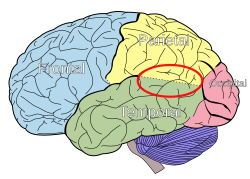Our website is made possible by displaying online advertisements to our visitors.
Please consider supporting us by disabling your ad blocker.
Temporoparietal junction
| Temporoparietal junction | |
|---|---|
 Side view of the human brain. TPJ is indicated by red circle. | |
 Side view of the human brain. TPJ is indicated by red circle. | |
| Identifiers | |
| Acronym(s) | TPJ |
| NeuroLex ID | nlx_144255 |
| Anatomical terms of neuroanatomy | |
The temporoparietal junction (TPJ) is an area of the brain where the temporal and parietal lobes meet, at the posterior end of the lateral sulcus (Sylvian fissure). The TPJ incorporates information from the thalamus and the limbic system as well as from the visual, auditory, and somatosensory systems. The TPJ also integrates information from both the external environment as well as from within the body. The TPJ is responsible for collecting all of this information and then processing it.[1]
This area is also known to play a crucial role in self–other distinctions processes and theory of mind (ToM).[2] Furthermore, damage to the TPJ has been implicated in having adverse effects on an individual's ability to make moral decisions and has been known to produce out-of-body experiences (OBEs).[3] Electromagnetic stimulation of the TPJ can also cause these effects.[4][5] Apart from these diverse roles that the TPJ plays, it is also known for its involvement in a variety of widespread disorders including anxiety disorders, amnesia, Alzheimer's disease, autism spectrum disorder, and schizophrenia.
- ^ Abu-Akel, A; Shamay-Tsoory, S (September 2011). "Neuroanatomical and neurochemical bases of theory of mind". Neuropsychologia. 49 (11): 2971–84. doi:10.1016/j.neuropsychologia.2011.07.012. PMID 21803062. S2CID 36226051.
- ^ Saxe, R; Kanwisher, N (August 2003). "People thinking about thinking people: The role of the temporo-parietal junction in "theory of mind"". NeuroImage. 19 (4): 1835–42. doi:10.1016/S1053-8119(03)00230-1. PMID 12948738. S2CID 206118958.
- ^ Blanke, O; Arzy, S (2005). "The Out-of-Body Experience: Disturbed Self-Processing at the Temporo-Parietal Junction". The Neuroscientist. 11 (1): 16–24. doi:10.1177/1073858404270885. PMID 15632275. S2CID 8172076.
- ^ Orrù, G.; Bertelloni, D.; Cesari, V.; Conversano, C.; Gemignani, A. (2001). "Targeting temporal parietal junction for assessing and treating disembodiment phenomena: a systematic review of TMS effect on depersonalization and derealization disorders (DPD) and body illusions". AIMS Neuroscience. 8 (2): 181–194. doi:10.3934/Neuroscience.2021009. PMC 7940112. PMID 33709023.
- ^ "Morality is modified in the lab". BBC News. 2010-03-30.
Previous Page Next Page


